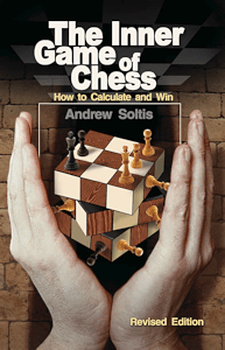| Nivå | B-D |
| Utgivelsesdato | Desember 2014 |
| Forfatter | |
| Pris | 240 NOK |
The Inner Game of Chess
How to Calculate and WinEn til av stormester Andrew Soltis sine tidlige klassikere i ny utgave, riktignok bare litt oppdatert og justert fra den opprinnelige i 1994.
Soltis klarer mer enn de fleste en troverdig balanse mellom det faglig holdbare og det praktisk tilgjengelige for oss vanlige folk.
Forlagets egen omtale
PDF-utdragDo masters methodically cut their way through the branches of a tree of analysis? Is it true that attacking players calculate a dozen moves ahead, while positional specialists rely on abstract principles? What exactly does it mean to “calculate,” anyway?
In The Inner Game of Chess, GM Andy Soltis shows that the key to good calculation is good visualization of the position in front of us and then after the moves we’re considering. Being aware of tactical motifs; knowing when to stop looking; and verifying your chosen move are essential, but they all depend on the basic requirement to see clearly what’s going on. The author discusses common obstacles to clear visualization and offers techniques to overcome them in your own play.
This 21st-century edition of Soltis’s celebrated work features new material and revised diagrams and analysis, while retaining all the insights that made The Inner Game of Chess an instant classic. About the Author
Popular Chess Life columnist Andy Soltis is the author of numerous other classics of chess literature, including Pawn Structure Chess, The Art of Defense in Chess, and Rethinking the Chess Pieces. A 2011 inductee into the U.S. Chess Hall of Fame, he received the International Grandmaster title in 1980.
Innhold
008 The Myth ofthe Long Variations
011 "Positional Players Don't Calculate"
015 "Calculation Means Finding Mates and Sacrifices"
019 The Joys of Ca1culating
023 Learning to Visualize
029 CHAPTER 2. Ideas
042 Master vs. Novice
050 Looking for the Weakness
052 Patterns
054 Hints
066 CHAPTER 3. Trees and How to Build Thern
070 A Family of Ideas
074 Candidate Moves
082 The Tree of Analysis
088 How Chessplayers Really Think
093 CHAPTER 4. Force
097 Let the Force
100 Force vs. Speed, Force vs. Force
109 Opening a Pandora's Box
114 The Limits ofForce
116 Force in Action
121 CHAPTER 5. Countlug Out..
122 The Bottom Line
124 First Step: Count the Pieces
136 What Is Compensation?
140 Is it Over?
154 Move Order
161 Serendipity and Sequence
163 Orders and Options
168 Bailout
172 Calculating in Stages
175 CHAPTER 6. Choice
185 Tactical vs. Technical vs. Positional...
189 Defensive Choice
195 CHAPTER 7. MonkeyWrenches
196 Assumption
205 Advanced Assumption
208 Quiet Move
212 Destruction of the Guard
216 Zwischenzug
221 Attack-Defense
226 Desperado
236 CHAPTER 8. Oversights
239 Simple Visual Oversights
243 Retreats
246 Line Blocks
249 Unveiled Attacks
252 The Retained Image
256 Optical Illusions
258 It's a Big Board
261 CHAPTER 9. Rechecking
263 Walkthrough
267 Where Are the Pieces?
273 Remember to Remember
276 Ghosts
281 Lasker 's Law
287 Improving the Breed
296 Achilles' Heel
300 CHAPTER 10. The Practical Calculator
307 When You Must Calculate
311 Getting Fancy
313 Beware Understandable Moves
317 Believing Hirn
324 Summing Up
| Innbundet? | Nei |
| Type | Bok |
| Førsteutgave år | 1994 |
| Språk | Engelsk |
| Antall sider | 324 |

